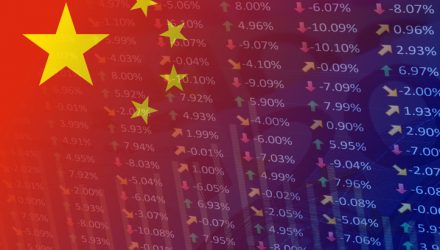It may seem like an odd time to be considering Chinese stocks and the related ETFs, particularly with trade tensions between the U.S. and China flaring back up again. Renewal of those tensions explains why the VanEck Vectors ChinaAMC CSI 300 ETF (NYSEArca: PEK) traded lower on Tuesday.
PEK targets the CSI 300 Index, “which is comprised of the 300 largest and most liquid stocks in the Chinese A-share market,” according to VanEck.
While trade relations between the world’s two largest economies remain volatile, there are still reasons to consider PEK, including China’s steady economic growth.
“Purchasing managers’ indices (PMIs) are a better indicator of the health of the Chinese economy than the gross domestic product (GDP) number, which is politicized and is a composite in any case,” said VanEck in a recent note. “The manufacturing and non-manufacturing, or service, PMIs have been separated in order to understand the different sectors of the economy. These days, the manufacturing PMI is the number to watch for cyclicality.”
PEK Potential
Like the majority of emerging markets, China hasn’t been immune to the pangs of the market volatility within the last couple of months due to the U.S.-China trade war. While some investors may look at these equities as a possible value-oriented option, one analyst says to watch out for potential value traps.
Thus far, the U.S. has imposed about $500 billion in tariffs on Chinese goods while retaliatory China tariffs were imposed on about $110 billion in American products. As trade negotiations continue, other politicians are wary that a “phase one” deal or any type of deal will resolve any issues between the two largest economies.
Fortunately, the People’s Bank of China (PBOC) has been active in propping up the economy there and that could be a boon for PEK going forward.
Related: Hong Kong ETFs Could Find Support from Chinese Investors
“As with any economy, central bank policy is very important in China. In this chart, we can see that interest rates for the private sector fluctuate, whereas the interest rates paid by state-owned enterprises (SOEs) are pretty stable,” according to VanEck.
PEK, which holds 300 stocks, allocates nearly 35% of its weight to financial services stocks and 24.4% of its weight to consumer staples and industrial names.
For more information on Chinese markets, visit our China category.
The opinions and forecasts expressed herein are solely those of Tom Lydon, and may not actually come to pass. Information on this site should not be used or construed as an offer to sell, a solicitation of an offer to buy, or a recommendation for any product.







